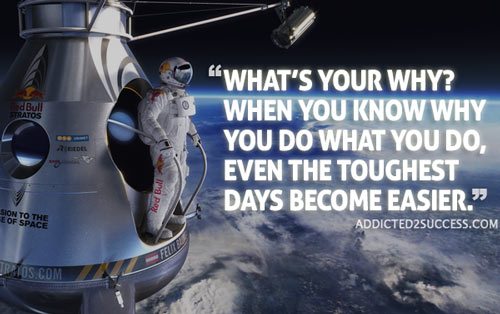Motivation
5 Straight-Forward Ways to Find Motivation Within Yourself
You’ve taken advice to start a new habit or set a new goal from someone that seems important and knowledgeable. But, most, if not all, of the time you fell short.
Even though it sounded like good and reasonable advice at the time, when it came to doing it, you either just didn’t, or you found some reason to rationalize not doing it. Either way, nothing inside you said, “no, I’m doing this.”
The reason it didn’t work is because if our motivation to do things comes from an outside source, the moment that outside source isn’t there any more (which is likely most of the time), we aren’t going to keep doing whatever it is we were trying to do.
So to make sure we actually stick to the plan, we have to be able to motivate ourselves, we can’t outsource motivation and hope to succeed. Getting the idea from an outside source is great, but to follow through, you have to internalize the motivation.
Here is 5 ways you can drive yourself to success:
1. What is your “because” clause?
If you don’t want your goals to slip into the abyss of “I’ll get to it when I have more time and energy” you have to understand why you have the goals you have.Meaning, there has to be a “because” clause at the end of declaration that you are going to achieve your goal.
For example: I am going to meditate for 15 minutes every morning because I want to have more clarity, focus, and presence.
If you don’t have “because” clause, you won’t be clear on why you are doing something. So, pushing yourself to keep going when it isn’t new and exciting, will be virtually impossible. Why torture yourself by slogging through the hard parts if you don’t even know why you are doing it.
Your “because” should be pretty easy to identify. Just ask yourself, what impact are you looking for in your life as a result of your goal? The answer should not be that you complete the goal. You have to figure you why you want to achieve your goal. Then, the motivation is the because clause in the sentence.

2. Give yourself only two options, succeed or fail
You don’t like to fail. I don’t either. It’s why we find it so hard to start something new, it means we might fail. It also creates a tendency in us to rationalize stopping or procrastinating when things get hard and it feels like we might fail. It is a seductive thing. We are very good at rationalizing why quitting is ok and why it is different than failing.
So, you have to guard against yourself. The best way to do that is to put yourself in a position that you can’t quit without failing. To do that you have to commit to what you are doing in a way that the only thing you can do is either do it, or fail.
Here’s how, and it works with whatever you are doing. Tell people what you are going to do. Tell them your “because” clause. And tell them you will not quit for any reason until you’ve done it. Tell people you respect, people whose opinion matters to it. Maybe it’s your spouse, your friends, your parents, or your colleagues. And then ask that person to follow-up with you regularly to check your progress.
This isn’t easy, but it is ridiculously effective. If you really want to push yourself, put yourself out there in a way that either you get the job done or you let down people you respect. You’ll be impressed at how hard you will work to make it happen.
3. The big picture isn’t that important. Focus on the small one
A huge reason we often lose motivation is that our goal feels so far away. If our goals are big and powerful, there’s probably a sizable gap from where we are to where we want to be. After we lose the buzz of getting started, covering that gap can feel impossible.
But in reality, that gap is just a bunch of small steps strung together. Each one of which you can absolutely do. And after you’ve done one, and then another, and then another, eventually you look up and you are nearly there. The key is to keep moving. In order to keep moving, you have to take those small steps.
So, how do you see a bunch of little doable steps instead of a uncoverable gap? I’m sure you’ve heard, break up your goal into smaller goals, six weeks, two weeks, one week. That’s good advice, but I’ve always found it really hard to follow.
Instead, I find telling myself that each day I have to spend 2 minutes doing something to take a little step towards my goal. If I get in 2 minutes, the day is a success and I feel good about things.
You’ll find if you just commit to the two minutes, you’ll often get more in. Two really is enough. It keeps you in touch with the goal, it creates and keeps momentum. You don’t have to sit down and create a year long plan with 52 week-long bench marks.
You just have to take two minutes and do something that moves the ball forward. You can do that every day. When you do, let yourself feel the success, don’t worry about how much you get done, it doesn’t matter. It only matters that you do it.
4. Can you see it? Touch it? Feel it?
After we set our sights on some audacious goal, if we want to stay motivated to complete that goal, we have to believe it is possible. As you may know, our brains are bad at telling reality from fiction. That’s why The Blair Witch Project freaked me out for quite a while after I learned it didn’t really happened. I knew it wasn’t real, but my mind saw it and there wasn’t anything my intellect could do about it.
You can hijack the same mechanism horror movies have been hijacking for decades. If you vividly picture yourself completing your goal, your brain will believe you can do it because it has already seen it, even though you just forced your brain to picture it.
It’s easy to do. I find, right before I go to sleep to be a good time. I’m always lying in a quiet dark place, so it’s perfect for visualizing things. Picture your success, what it feels like, sounds like, and if it has a smell or taste, add that in. The more senses you can get involved, the better. Then drift off to sleep knowing you’ve made that success a little easier as a result.
“Very little is needed to make a happy life; it is all within yourself, in your way of thinking.” – Marcus Aurelius
5. Visualize failure
Sometimes I need a little kick in the pants. You probably do too. Visualizing your success is important to getting yourself to believe you can actually achieve whatever you have set out to achieve. But on the days when you don’t even feel like spending the two minutes I discussed above, and we all have them, negative visualization is the trick you need.
You visualize what your life looks like in a month, year, or five years if you quit and fail to achieve your goal (the time is relative to the goal you have, pick the time frame you expected to complete your goal if you stick to it). Really visualize it.
Now, because you obviously want to succeed, having a clear picture of failure will push you to take the two minutes and do something that pushes you forward and guarantees you don’t fail today.
You’ll act so you make sure what you just visualized never comes to fruition. After you take that action, and this is critical, congratulate yourself and picture your success and how you took yet another step toward it. Don’t let the negative image sit on your brain.
What luck, you are absolutely in control of your own success
You are going to be the biggest reason you succeed. No one talks to you more than you talk to yourself. No one has more control over how you spend your day. Take advantage of the position you have as the person in charge of your life. When you have a goal you want to achieve, use the five strategies above to push yourself towards that success.
Thanks for reading my article! What things do you do that help find the inner motivation to push you?
Life
10 Research-Backed Steps to Create Real Change This New Year
This New Year could finally be the one where you break old patterns and create real, lasting change.

Every New Year, we make plans and set goals, but often repeat old patterns. (more…)
Life
How Sports Quietly Build Kids’ Emotional Intelligence And Why It Matters for Life
Sports create a natural loop of awareness and action that kids carry into real life

A missed shot in basketball. A tumble during a gymnastics routine. A tough loss in karate sparring. These moments can feel huge to a child, sparking frustration, embarrassment, or even tears. (more…)
Did You Know
7 Surprising Life Lessons Video Games Taught Me That School Never Did
Want to get better at something? Study the pros. That applies to both life and video games

If you play video games, you’ll quickly discover you’re not alone. You’ll meet people who share your interests, challenge your skills, and even teach you something new about yourself. I started gaming when I was 10. A classmate invited me to play after school, and I was hooked. (more…)
Featured
The Psychology of Motivation: How to Keep Moving Forward Every Day
Discover how daily habits, self-discipline, and a few clever strategies can spark your drive and focus.

You wake up on a typical Monday morning, glance at your clock, and realize it’s time to get moving. How do you summon that inner drive to deal with your responsibilities with a genuine smile on your face? (more…)
-

 Entrepreneurs4 weeks ago
Entrepreneurs4 weeks agoThe Essential Skills Every Entrepreneur Needs In 2026
-

 Change Your Mindset4 weeks ago
Change Your Mindset4 weeks agoHow to Turn Your Mind Into Your Greatest Asset (Instead of Your Enemy)
-

 Change Your Mindset3 weeks ago
Change Your Mindset3 weeks agoThe Silent Skill That Makes People Respect You Instantly
-

 Life3 weeks ago
Life3 weeks ago10 Research-Backed Steps to Create Real Change This New Year
-

 Tech3 weeks ago
Tech3 weeks agoWhat’s in a Name? How to Get Your Domain Right
-

 Did You Know2 weeks ago
Did You Know2 weeks agoHow Skilled Migrants Are Building Successful Careers After Moving Countries

























3 Comments